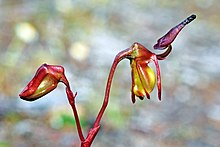| Hort's duck orchid | |
|---|---|

| |
| Scientific classification | |
| Kingdom: | Plantae |
| Clade: | Tracheophytes |
| Clade: | Angiosperms |
| Clade: | Monocots |
| Order: | Asparagales |
| Family: | Orchidaceae |
| Subfamily: | Orchidoideae |
| Tribe: | Diurideae |
| Genus: | Caleana |
| Species: | C. hortiorum |
| Binomial name | |
| Caleana hortiorum (Hopper & A.P.Br.) M.A.Clem. | |
| Synonyms | |
Caleana hortiorum, commonly known as Hort's duck orchid is a species of orchid endemic to the south-west of Western Australia. It has a single smooth leaf, a single greenish yellow and red flower and is distinguished by its long, narrow, slightly humped labellum, with calli on its outer half. It is found between Perth and Albany.
Description
Caleana hortiorum has a single smooth, dull green or dull red leaf, 10–20 mm (0.4–0.8 in) long and 4–8 mm (0.2–0.3 in) wide. Unlike those of most other caleanas, the leaf is not withered at flowering time. Usually only one greenish-yellow and red flower, 10–12 mm (0.4–0.5 in) long and 6–8 mm (0.2–0.3 in) wide is borne on a thin, wiry stalk 70–110 mm (3–4 in) high. The dorsal sepal, lateral sepals and petals are narrow and hang downwards with the dorsal sepal pressed against the column which has broad wings, forming a bucket-like shape. About one half of the outer part of the labellum is covered with glossy black glands or calli and the labellum has a slightly humped top. Flowering occurs in September and October.
Taxonomy and naming
Hort's duck orchid was first formally described in 2006 by Stephen Hopper and Andrew Brown who gave it the name Paracaleana hortiorum. The description was published in Australian Systematic Botany from a specimen collected near York. In 2014, based on molecular studies, Joseph Miller and Mark Clements transferred all the species previously in Paracaleana to Caleana so that the present species became Caleana hortiorum. The specific epithet (hortiorum) honours Fred and Jean Hort who were early collectors of this species.
Distribution and habitat
Caleana hortiorum grows in clearings in shrubland and woodland between Perth and Albany in the Esperance Plains, Jarrah Forest and Swan Coastal Plain biogeographic regions.
Conservation
Caleana hortiorum (as Paracaleana hortiorum) is classified as "not threatened" by the Western Australian Government Department of Parks and Wildlife.
References
- ^ "Caleana hortiorum". APNI. Retrieved 16 April 2018.
- ‹ The template below (WCSP) is being considered for deletion. See templates for discussion to help reach a consensus. ›
"Caleana hortiorum". World Checklist of Selected Plant Families (WCSP). Royal Botanic Gardens, Kew.
- ^ Hoffman, Noel; Brown, Andrew (2011). Orchids of South-West Australia (3rd ed.). Gooseberry Hill: Noel Hoffman. p. 248. ISBN 9780646562322.
- ^ Brown, Andrew; Dundas, Pat; Dixon, Kingsley; Hopper, Stephen (2008). Orchids of Western Australia. Crawley, Western Australia: University of Western Australia Press. p. 303. ISBN 9780980296457.
- "Paracaleana hortiorum". APNI. Retrieved 16 April 2018.
- Miller, Joseph T.; Clements, Mark A. (2014). "Molecular phylogenetic analyses of Drakaeinae: Diurideae (Orchidaceae) based on DNA sequences of the internal transcribed spacer region". Australian Systematic Botany. 27 (1): 3–22. doi:10.1071/SB13036. Retrieved 16 April 2018.
- ^ "Paracaleana hortiorum". FloraBase. Western Australian Government Department of Biodiversity, Conservation and Attractions.
| Taxon identifiers | |
|---|---|
| Caleana hortiorum | |
| Paracaleana hortiorum | |